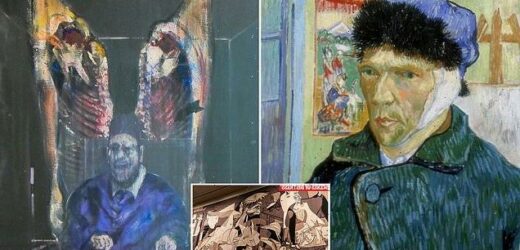From ‘scenes of distress’ in Picasso’s Guernica to ‘depiction of self-harm’ in Van Gogh’s famous head bandage… what art could be the next hit with ‘woke’ warnings after Manet’s A Bar at the Folies-Bergère
- Édouard Manet’s 1882 work A Bar at the Folies-Bergère was given new label at the Courtauld Gallery
- Says barmaid’s expression is ‘unsettling, especially as she appears to be interacting with a male customer’
- It prompted MailOnline to take a light-hearted look at famous works that could be hit with ‘woke’ warnings’
- Include Picasso’s Guernica, for ‘scenes of distress’ and van Gogh’s self-portrait for ‘depiction of self-harm’
The move by curators at the Courtauld Gallery to add ‘woke’ new labels to its collection of famous paintings is just the latest in a string of similar moves in the art world.
Édouard Manet’s 1882 work A Bar at the Folies-Bergère is one of the paintings that received a new label at the Courtauld, because it depicts a barmaid standing opposite a male customer and the woman’s expression is ‘unsettling’.
Warnings and updated information boards have also previously been added elsewhere to works by William Hogarth, Francis Bacon, John Constable and many others.
Whilst some artists have been highlighted because of their alleged links to slavery, curators have also previously warned about an exhibition’s distressing themes.
The examples above have prompted MailOnline to take a light-hearted look at what other famous works of art could be hit with ‘woke’ warnings.
They include Pablo Picasso’s Guernica, which depicts the suffering brought on by the violence and chaos of the bombing by Nazi Germany and Fascist Italy of the Spanish town of the same name.
Francis Bacon’s 1954 work Figure With Meat might need a label warning that it could upset vegans with its gruesome depiction of two halves of a beef carcass either side of Pope Innocent X.
Also shown below is Vincent van Gogh’s 1889 self-portrait, in which he is seen with his left ear bandaged after using a razor blade to sever part of it.
Whilst Guernica might be deserving of a ‘scenes of distress’, van Gogh’s work might need a message to warn of the ‘depictions of self-harm’.
Pablo Picasso’s Guernica – ‘Scenes of distress’
Spanish painter Picasso produced what is possibly his most famous work in just 25 frenzied days.
It depicts screaming mothers, dead children and severed limbs and could qualify for a ‘scenes of distress’ label.
Guernica, in the Basque region of Spain, was bombed on 26 April 1937 during the Spanish Civil War and an estimated 200 to 250 people were killed.
Spanish painter Picasso produced what is possibly his most famous work in just 25 frenzied days. It depicts screaming mothers, dead children and severed limbs. It would qualify for a warning about its ‘scenes of distress’
The aerial bombardment of the town was carried out by Nazi German and Italian Fascist forces who were supporting their Spanish ally Francisco Franco.
Franco viewed the Basque region of Spain as a strong hold for resistance during the Civil War and targets for the bombing were civilian
For Nazi Germany and Fascist Italy it was an opportunity to practice aerial bombing of civilians before the Second World War.
Vincent van Gogh’s Self-Portrait with Bandaged Ear – ‘Depictions of self-harm’
Dutch painter Vincent van Gogh’s 1889 work is one of his most famous and would be a prime candidate for a warning highlighting its depictions of self-harm.
Known for his distinctive self-portraits, this particular piece captures van Gogh after he famously cut off part of his own ear – although historians have debated whether he was maimed by somebody else.
Completed the year before his death, the painting shows van Gogh smoking a pipe and wearing a hat.
Historians do know that Van Gogh suffered from bipolar disease and his generally poor health was made worse by heavy smoking, a poor diet and bouts of gonorrhea contracted in the brothels he frequented
Experts believe that these factors combined led Van Gogh to slash off his ear before taking his own life.
Dutch painter Vincent van Gogh’s 1889 work is one of his most famous and would be a prime candidate for a warning highlighting its depictions of self-harm
Edvard Munch’s The Scream – ‘Scenes of a harrowing nature’
‘The Scream’ is the popular name given to each of five versions of a composition created by the Expressionist artist Edvard Munch between 1893 and 1910.
The work’s depiction of a figure with an agonized expression against a landscape with a swirling orange sky would likely qualify for a ‘trigger warning’, highlighting ‘scenes of a harrowing nature’.
Munch created the five versions of his artwork in various media, including paint and pastel.
It is estimated that each composition is worth over £110 million.
The Norwegian artist’s work has previously been hailed as ‘one of the most iconic images in art history’ by the director of the British Museum.
The most famous version of the artwork, a painting from 1893, sold at auction for a record $119.9 million in 2012.
‘The Scream’ is the popular name given to each of five versions of a composition created by the Expressionist artist Edvard Munch between 1893 and 1910
Michelangelo’s David – ‘May contain nudity’
The original ‘David’ statue was created by Italian sculptor Michelangelo and first unveiled in 1504.
It depicts the Biblical hero David as he prepares to fight Goliath, the giant nemesis that he overcomes.
The Renaissance sculpture, which shows David fully naked, stands at 14ft tall and is made entirely out of marble.
Because of the absence of any clothes to cover his modesty, the statue might be the subject of a warning about its nudity.
The original ‘David’ statue was created by Italian sculptor Michelangelo and first unveiled in 1504. It depicts the Biblical hero David as he prepares to fight Goliath, the giant nemesis that he overcomes. Because of the absence of any clothes to cover his modesty, the statue might be the subject of a warning about its nudity
It took Michelangelo over two years to complete and was originally meant to be displayed in a cathedral.
However, a committee of artists including Leonardo Da Vinci decided the statue was too perfect to be hidden away, and it was instead displayed in the centre of Florence in the Piazza della Signoria.
It now stands in the Galleria dell’Accademia in Florence.
Rogier van der Weyden’s Last Judgment – ‘May be offensive to non-Christians’
The Dutch artist created his famous Christian work, which is divided into panels that are collectively known as a polyptych, between 1445 and 1450.
The painting depicts possible fates of the viewers. Whilst some of the figures in the work are seen in heaven, those who God has looked on unfavourably are shown naked and suffering as they appeal for last-minute salvation on Judgement Day.
Some non-Christians might consider the painting offensive for its depiction of the possible consequences of getting on the wrong side of God.
Rogier van der Weyden created his famous Christian work, which is divided into panels that are collectively known as a polyptych, between 1445 and 1450
Peter Paul Rubens’s Massacre of the Innocents – ‘Scenes of blood and gore’
Painted in 1611, Massacre of the Innocents is Flemish artist Reubens’ depiction of King Herod’s order to kill every young male in Bethlehem, as recounted in the Bible’s Gospel of Matthew.
Its scenes of nude men tearing babies from the arms of their mothers and then murdering their children in front of them would certainly qualify for a label that warns of ‘scenes of blood and gore’.
According to the Biblical account, Herod ordered the murder of all boys under the age of two in the hope of ensuring that the newborn Baby Jesus would also be killed.
Painted in 1611, Massacre of the Innocents is Flemish artist Peter Paul Reubens’ depiction of King Herod’s order to kill every young male in Bethlehem, as recounted in the Bible’s Gospel of Matthew
Artemisia Gentileschi’s Judith Slaying Holofernes – ‘Scenes of gratuitous violence’
Female artist Artemisia Gentileschi 1620 depiction of the Old Testament story of widow Judith, who assassinated the Assyrian general besieging her city, shocked 17th-century Italy.
Holofernes, who had wanted to bed Judith, is seen with blood spraying from his neck as the widow’s sword is thrust under his chin.
The scene was more similarly depicted by male Italian painter Carvaggio in his own work around 20 years earlier.
Given what it depicts some may feel it is deserving of a warning to highlight the ‘scenes of gratuitous violence’.
Female artist Artemisia Gentileschi 1620 depiction of the Old Testament story of widow Judith, who assassinated the Assyrian general besieging her city, shocked 17th-century Italy
Francis Bacon’s Figure with Meat – ‘May be upsetting to vegans’
The English painter’s 1954 work is part of a famous series which Bacon based on Diego Velázquez’s 1650 Portrait of Pope Innocent X.
Bacon transformed Velázquez’s portrayal of papal authority into a nightmarish image, with his mouth open in a scream. He is flanked by two halves of a cow.
The beef carcass is believed to derive from Dutch master Rembrandt’s 1655 work Slaughtered Ox.
Bacon’s work might be deserving of a warning to highlight that it ‘may be upsetting to vegans’.
The English painter’s 1954 work is part of a famous series which Bacon based on Diego Velázquez’s 1650 Portrait of Pope Innocent X. Bacon transformed Velázquez’s portrayal of papal authority into a nightmarish image, with his mouth open in a scream. He is flanked by two halves of a cow
Salvador Dali’s The Face of War – ‘Scenes of mild terror’
Spanish surrealist Salvador Dali created The Face of War in 1940, when he was living in California.
The painting, which could have been inspired by the trauma of the Spanish Civil War, might be in need of a content warning for the ‘scenes of mild terror’ that it depicts.
It shows a disembodied face set against the backdrop of a barren desert landscape. The face is withered like a corpse’s and wears an expression of misery.
Swarming around the face are serpents, whilst in its mouth and eye sockets, there are identical faces. In the mouths and eyes of the smaller faces, there are further identical depictions.
Spanish surrealist Salvador Dali created The Face of War in 1940, when he was living in California. The painting, which could have been inspired by the trauma of the Spanish Civil War, might be in need of a content warning for the ‘scenes of mild terror’ that it depicts
Manet masterpiece given ‘MISOGYNY’ alert over ‘male gaze’: London’s Courtauld Gallery puts ‘woke’ warning beneath 1882 piece A Bar at the Folies-Bergère… due to barmaid’s ‘unsettling’ expression about man shown in mirror
By Harry Howard, History Correspondent for MailOnline
The Courtauld Gallery has been criticised for introducing a ‘woke’ new label on a Manet masterpiece to warn viewers of the ‘unsettling’ presence of a man.
The London gallery, which holds the UK’s most prestigious collection of Impressionist paintings, reviewed its labelling as part of a £57million refurbishment.
Édouard Manet’s 1882 work A Bar at the Folies-Bergère is one of the paintings that has received a new label.
The work depicts a barmaid at the famous Parisian cabaret club staring at the viewer and a male customer who can be seen in a mirrored image behind her.
The new information panel both in the gallery and online states that the female subject’s ‘enigmatic expression is unsettling, especially as she appears to be interacting with a male customer’.
Speaking to The Telegraph, art historian Ruth Millington branded the interpretation a ‘woke attempt to call out misogyny’ which ‘unwittingly centres the male gaze’ by shifting the viewer’s attention to the man.
Another painting that bears a new label is Paul Gauguin’s 1897 work Nevermore. The updated panel says that the painting depicts ‘one of several teenagers that he took on as ‘wives”.
It then adds that ‘the widespread racist fantasy of Tahitian girls as sexually precocious led to their unabashed exploitation.’
The Courtauld Gallery has been criticised for introducing a ‘woke’ new label on the Manet masterpiece A Bar at the Folies-Bergère. It warns viewers of the ‘unsettling’ presence of a man
Completed a year before he died, 1882 work Folies-Bergère was Manet’s last major painting. Above: The artist in 1875
Completed a year before he died, Folies-Bergère was Manet’s last major painting.
Whilst the background shows a fashionable mingling crowd, a trapeze artist is seen top left in green boots.
In front of the barmaid are a series of alcoholic drinks.
Most of the scene is a reflection in the large gold-framed mirror that hangs behind the barmaid, whose model was a real woman called Suzon who worked at the Folies-Bergère.
The venue was known to be popular for prostitutes plying their trade and historians have previously suggested that the painting hints at the exploited barmaid’s availability to male customers.
The painting’s new label adds that the barmaid ‘appears as just another item in the enticing array on offer in the foreground: wine, champagne, peppermint liqueur and British Bass beer, with its iconic red triangle logo.’
Ms Millington, who has written a book focusing on the female inspirations in art, said: ‘In a painting of multiple gazes, it’s unfair and misogynistic to emphasise the male perspective.
‘I’d rather read a fresh new label which invites viewers to imagine what the woman is thinking.’
The new interpretation of French painter Gaugin’s work Nevermore criticises the artist for ‘taking advantage of his position as a European coloniser’.
Another painting that bears a new label is Paul Gauguin’s 1897 work Nevermore. The updated panel says that the painting depicts ‘one of several teenagers that he took on as ‘wives”
It then adds that ‘the widespread racist fantasy of Tahitian girls as sexually precocious led to their unabashed exploitation’
The Post-Impressionist artist had a home on the island of Tahiti, which is still an overseas territory of France.
The gallery’s re-labelling follows the reassessment of other well-known artists at major galleries.
The Tate Britain’s exhibition on Hogarth was criticised after curators highlighted the ‘sexual violence, anti-Semitism and racism’ in the painter’s works.
And staff at the National Gallery carried out a three-year audit which linked hundreds of its famous paintings to slavery.
The Courtauld has been contacted for comment.
Source: Read Full Article















